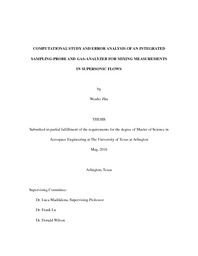
ATTENTION: The works hosted here are being migrated to a new repository that will consolidate resources, improve discoverability, and better show UTA's research impact on the global community. We will update authors as the migration progresses. Please see MavMatrix for more information.
Show simple item record
| dc.contributor.advisor | Maddalena, Luca | |
| dc.creator | Zhu, Wenbo | |
| dc.date.accessioned | 2017-09-13T14:33:54Z | |
| dc.date.available | 2017-09-13T14:33:54Z | |
| dc.date.created | 2016-05 | |
| dc.date.issued | 2016-05-10 | |
| dc.date.submitted | May 2016 | |
| dc.identifier.uri | http://hdl.handle.net/10106/26923 | |
| dc.description.abstract | Concentration probes are employed in supersonic flow mixing experiments for binary gas mixture composition measurements. These measurements are fundamental for the advancement of the scramjet technology. While non-intrusive laser-based methods (such as planar laser-induced fluorescence and filtered Rayleigh scattering) have been developed greatly over the past few decades, intrusive methods (such as concentration probes) still play an essential role in the measurement of mixture composition due to the fact that, with correct application, they do not require further assumptions on the aerothermodynamic states of the investigated mixture, which are often difficult to corroborate. Conversely, such assumptions are essential to the measurement of the mixture composition with current non-intrusive methods. Because the typical design of these probes is essentially based on an inviscid, adiabatic, quasi-one-dimensional analysis, the scope of this work is to better understand and quantify the severe impact of viscous effects on the probe’s internal gasdynamics and the associated uncertainties in the measured quantities via a computational fluid dynamics analysis. Specifically, the focus is on the augmented errors due to the aforementioned viscous effects when coupled with various cases of probe-flow misalignment, which is a typical scenario encountered in mixing measurements of binary gas compositions (air and helium mixture in the present work) in vortex-dominated flows. Results, new in literature, show phenomena such as shock-induced boundary layer separation and the formation of an oblique shock train. These flow features are found to noticeably affect the accuracy of the composition measurement. The errors associated with the inviscid, adiabatic, quasi-one-dimensional analysis of the probes are quantified in this study. The computational model developed in this work is also used to design a probe that can minimize such errors in mixture composition measurements. | |
| dc.format.mimetype | application/pdf | |
| dc.language.iso | en_US | |
| dc.subject | Concentration probe | |
| dc.subject | CFD | |
| dc.subject | Composition measurements | |
| dc.title | Computational Study and Error Analysis of an Integrated Sampling-Probe and Gas-Analyzer for Mixing Measurements in Supersonic Flows | |
| dc.type | Thesis | |
| dc.degree.department | Mechanical and Aerospace Engineering | |
| dc.degree.name | Master of Science in Aerospace Engineering | |
| dc.date.updated | 2017-09-13T14:33:54Z | |
| thesis.degree.department | Mechanical and Aerospace Engineering | |
| thesis.degree.grantor | The University of Texas at Arlington | |
| thesis.degree.level | Masters | |
| thesis.degree.name | Master of Science in Aerospace Engineering | |
| dc.type.material | text | |
| dc.creator.orcid | 0000-0002-7684-8716 | |
Files in this item
- Name:
- ZHU-THESIS-2016.pdf
- Size:
- 3.088Mb
- Format:
- PDF
This item appears in the following Collection(s)
Show simple item record


